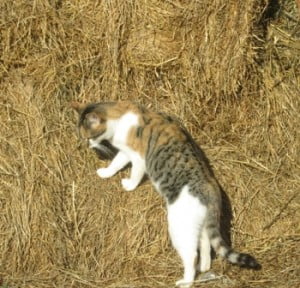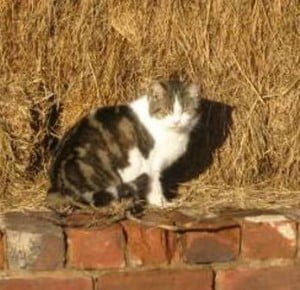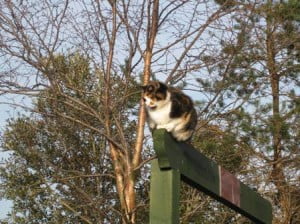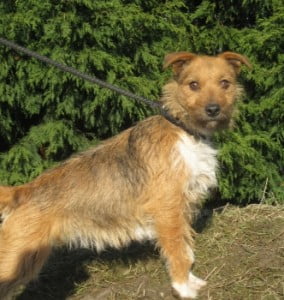Pet Advice Guides for Pet Owners
Pets must go green
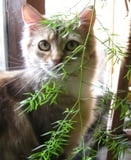 Although we talk a lot about our energy saving efforts, there’s not much being said about the true cost of keeping a pet. I’m not talking about how much we spend but what the cost is to the environment. Not so many years ago, cats and dogs were easy to keep and left the lightest of pawprints. Most houses had a cat, she was on the payroll and caught mice as well as being a charming feline friend. Her food was simple and cheap, no tins, no packaging.
Although we talk a lot about our energy saving efforts, there’s not much being said about the true cost of keeping a pet. I’m not talking about how much we spend but what the cost is to the environment. Not so many years ago, cats and dogs were easy to keep and left the lightest of pawprints. Most houses had a cat, she was on the payroll and caught mice as well as being a charming feline friend. Her food was simple and cheap, no tins, no packaging.
We fetched her a few fish bits from the local fishmonger. (big sigh for the lost local shops) A few scraps of meat from the butcher or she’d have left overs from our meals. A dish of brown bread and milk for her breakfast and anything else she could scrounge. Lots of freedom and the cats in those days never seemed to need the vet.
This is an old chap called Kimme, who still has this kind of lifestyle and is nearing twenty, hale and hearty. The main point I am making is that this is a ‘green’ life with a very small environmental footprint. Did these cats have toys? They were (and are) certainly very playful but with natural resources – chasing leaves made a great game. Kimme has been at the sanctuary for many years and is still active and playful. He does a lot of mousing (or pretends to now he’s getting on!), socializes with his pals and leads an old fashioned healthy cat life. Kimme loves fish and meat scraps and will only eat convenience food if he is very hungry. ‘What is this?’
This is Tortie who likes to climb as high as she can – hoping for an unwary bird maybe. A cat is a different species to us and their natural wants and desires are not the same. We didn’t buy plastic toys or expensive dishes for our pets – an old saucer was perfect. There were no factories manufacturing pet food – yes, I’m afraid that behind all those lovely labels there is a big industrial unit. Do you imagine that the preformed chunks are stewed on an Aga in a country kitchen? The pet food industry is BIG BUSINESS!
It’s just the same for dogs. What do they need? A wooden basket or an old carpet and a blanket in the corner. A hay bed in an outhouse is bliss for a lot of dogs – houses are too hot for them and they love the smell of hay. A natural life, plenty of meat because the dog is a carnivore. Off we go to the butchers again. No we can’t, the local butcher is long gone. A bit of toasted brown bread with gravy along with meat scraps made a good meal for a hungry dog who’d been running about outside all day. A boiled egg when the hens were laying, big bones when the butcher had them, left over fish ….. those were the days. Again it was environmentally friendly, no transport, no cans, no shops, no mark ups and boxes and special offers – most of all – nothing to dispose of!
Dogs leads were leather or plaited string, easy enough to make your own. Why buy plastic from the other side of the earth? Because it’s a pretty colour? Does your dog care?
The disposal of cans and pet food bags and plastic trinkets and gadgets and packaging is a mammoth problem. A lot of it finishes up in China. If our cats and dogs could understand, they would think we are mad. Perhaps they do think that anyway. They may love us, but we’re a crazy species.
What is important is to save the Planet for Pets. The endless pet consumerism does nothing for them and is a response to the human desire to shop and spend money most people can’t afford anyway.
- Feed as much natural and organic food as possible
- If your pets like toys, make them – feathers on sticks, screwed up silver paper, socks stuffed with other socks etc.
- Use recycled goods for bedding instead of buying new
- Make a dog bed from left over wood
- Use free cardboard boxes for the cats (and small dogs)
- Newspaper is clean and warm on the base
- Avoid packaging and only buy items that can be recycled
- Find a butcher who’ll give you big bones for your dog to chew, nothing sharp or small or spintery though.
- Clean your pet’s bedding with natural products, vinegar, orange, herbs, bi-carbonate of soda etc. (more soon about usage)
- Train your cat to go outside to the toilet and save on cat litter
- Use torn up newspaper for litter if you have to put down a tray.
- Use herbs to freshen pet beds up
- Dilute natural herbal oils to keep your pet smelling good and free of pests – lavender and tea tree are good.
- Make your own dog biscuits (toasted brown bread soaked in gravy) and bake scraps for treats when the oven is on anyway.
We all love our dogs and cats but by keeping them in an unnatural way we risk changing them as a species. Destroying the planet around them takes away their future. There’s a lot at stake. Nobody seems to realise how much the way we keep pets has changed over the past thirty years. It was simpler and cheaper to keep a dog or cat then. There was an element of survival of the fittest about some aspects but was that such a bad thing? Nobody surely wants sickly, weak animals who are always having veterinary treatment. There was less pedigree breeding in the past and dogs chose a mate for themselves. Plenty of hybrid vigour. Isn’t it time to make pets affordable again so that we can enjoy them without it really costing the earth.

